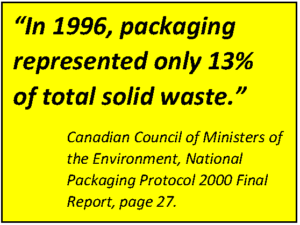There is no doubt that some goods are over-packaged and that more can be done to reduce the amount of paper, glass, metal and plastic packaging that ends up in consumers’ homes. But blaming packaging all the time is only part of the story. To put it bluntly, we in the so-called developed world eat, drink and buy far too much stuff.
Consumption is the real issue, not the packaging that delivers it. As consumers, however, we find it difficult to limit what we purchase. It’s so much easier to point the finger at the packaging that’s left behind.
For example, a recent anonymous letter to the editor of Solid Waste & Recycling magazine outlines the increase in convenience packaging of produce (plastic bags for peppers, a bundle of herbs in a plastic case, fresh grapes in a plastic bag with grab-and-go handles). The writer complains that the increased packaging waste from this new convenient shopping trend means higher costs for municipalities dealing with it down the line. A reasonable argument.
It’s when the letter writer rather loosely broadens the attack to packaging in general that we get concerned. “Our waste streams are clogged with unnecessary packaging at every turn,” he/she writes, “and most of it is neither recyclable nor compostable.”
Now hang on a minute there! If you are talking about convenience packaging of fresh produce (the peppers, herbs and grapes above) then you might have a point, although we suspect there will be debate over exactly what “necessary” means.
But when you broaden the issue to all packaging, you are lumping all packaging together in the same boat. Setting aside the argument over what might be deemed necessary or unnecessary, packaging is definitely not “clogging” our waste streams “at every turn.” In the most comprehensive national survey of packaging ever done in Canada, packaging represented only 13% of total solid waste. Significant, but not exactly “clogging.”

This survey was conducted by Statistics Canada for the Canadian Council of Ministers for the Environment (CCME) and is admittedly now some 20 years old, but there’s no obvious reason why the percentage would not be hugely different if measured today. Some people (including the Ontario Ministry of Environment and Climate Change) claim a higher percentage, but that’s because they change the denominator, they use a much narrower definition of solid waste.
It’s the claim that “most of it is neither recyclable nor compostable” that really gets us going though. Again, if the writer is talking about specific convenience packaging for produce, he/she might have a case. But by far most packaging used in Canada is able to be recycled (recyclable). And a fair chunk of it (mostly paper-based) is compostable. Whether it is actually being recycled and composted is an issue for another day, and an argument for better and more current national data.
